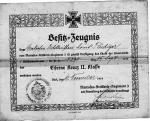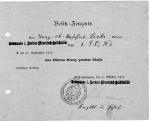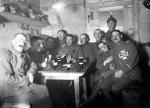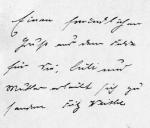-
Posts
2,143 -
Joined
-
Last visited
-
Days Won
10
Content Type
Profiles
Forums
Blogs
Gallery
Events
Store
Everything posted by Odulf
-

Franciscan monk with Egypt Medal?
Odulf replied to Odulf's topic in Great Britain: Orders, Gallantry, Campaign Medals
That is a possibility. It is remarkable in that case that he is wearing his medals and had his picture taken in Alexandria. Also funny, to see a medal (Khedive's Star) with Muslim symbols (half moon and star) on a Christian religious "uniform". -
Gentlemen, Today I received this strage CdV photo, of a Franciscan monk with Egypt Medal (no clasp) and Khedive's Star. The photographer is the French N.Fettel & Cie in Alexandria (Egypt) and the phto dates from about 1885. I am familiar with the British campaigns in Egypt and the Sudan, and the Egypt Medal. I know that the Army and Navy had their padres (I have had a small collection of Naval Chaplains' medals), but what about this character? Can any of you enlighten me?
-
I have the idea that matters are being mixed. An egg is not an apple, though they take a similar shape. First of all, the naming Hindenburg Cross, is a nomenclature for 3 cross shapend medals, all issued during the government of the German Predident Paul von Hindenburg. One type for combattants, one for non-combattants and one for widows and next of kin. The medal was instituted to replace the many semi-official and non-official medals that were issued after the conclusion of the war, to reward all who were participants and/or affected by the war The Turkish War Medal was of a completely different standing, and not a general token of involvement. Thus, I feel that the TWM is not to be compared to the Hindenburg Cross. Besides, the Turkish people, being mainly Muslims, would not easily carry a cross-shaped and therefore in origine Christian badge.
-

EK 1914 EK 1 & 2 documents to the Kaiserliche Marine
Odulf replied to Odulf's topic in Germany: All Eras: The Iron Cross
Quite stunning Chris, that turns me on What puzzles me, is that some pre Armistice ceritifcates are printed Vorläufges-Besitzzeugnis and others are not (mine has even the word Vorläufiges added by pen). One would think that, considering that all certificates are provisionally in waiting for the end of the war and the definitive official Governmental certificates, all pre Armistice docments would me marked as such. But obviously they are not. -

Heer Dutch army uniforms recycled
Odulf replied to Odulf's topic in Germany: Third Reich: Uniforms, Headwear, Insignia & Equipment
An Infantry soldier in a somewhat large parade dress, but with a Dutch Army belt. These were dark brown and with an iron clasp with a single pin. -

Heer Dutch army uniforms recycled
Odulf replied to Odulf's topic in Germany: Third Reich: Uniforms, Headwear, Insignia & Equipment
-

Heer Dutch army uniforms recycled
Odulf replied to Odulf's topic in Germany: Third Reich: Uniforms, Headwear, Insignia & Equipment
-
When the Dutch Army was disbanded in the summer of 1940, the Germans got hold of thousands of uniforms, weapons and equipment. The soldiers had to reurn their woolen grey-green uniforms, which had a colour rather similar to the German field-grey, and so the German Army re-used these for their own purpose. Thus the Germans took off the standing collar and replaced it by a laying collar, they replaced the brass buttons with rampant lion, but they did not always replaced the typical breast pockets. Many of these uniforms were issued to Russian volonteers, such as Cossacks, but also others wore the Dutch jackets. First a picture of Dutch soliers in about 1939 collecting their money.
-

EK 1914 The simple WW1 EK2...
Odulf replied to Chris Boonzaier's topic in Germany: All Eras: The Iron Cross
-

EK 1914 EK 1 & 2 documents to the Kaiserliche Marine
Odulf replied to Odulf's topic in Germany: All Eras: The Iron Cross
A pre-set Besitzzeugnis EK2 printed in brown ink, of Matrosen-Artillerie-Regiment 3, to a Matrosen-Artilleristen who served in Western Flanders. Notable is the signature of Marine-Zahlmeister (Naval Paymaster) Tirnstein who was obviously "mit Abwicklung der Geschäfte beauftragt" (in charge of liquidation of affairs). -

EK 1914 EK 1 & 2 documents to the Kaiserliche Marine
Odulf replied to Odulf's topic in Germany: All Eras: The Iron Cross
The Besitzzeugnis of a Torpedo-Obermaschinist, post war dated 27-9-1919. In 1919 he was submitted to the 1. Nordsee-Minensucht-Halbflottille / 2. Torpedoboots-Division. It is interesting to note that the A5 size document has been torn off, as the top shows little teeth not unlike those found as edge on stamps. -
Gentlemen, I am very fond of award documents of medals an decorations to the German Navy. Question: does any one know how many EK2 and EK1 have been awarded to Navy personnel for the Great War, and how that compares to the Army? Next some EK2 documents from my collection. Many EK documents were made up after Armistice, but this particular preleminary Besitzzeugnis was awarded to an Obermatrose o/b SM Linienschiff Nassau on 29-8-1917. The signature is of the ship's captain (from 12-1-1917 / 10-11-1918) Kapitän zur See Victor Reclam, who was pensioned in January 1920 as Konteradmiral. SMS Nassau, with a complement of 1000, saw much action in 1916. The most note worthy were the bombardment of Great Yarmouth and Lowestoft in April; the Battle of Jutland, where combined artillery from SMS Nassau, Thüringen, Ostfriesland and Friedrich der Grosse sank the RN armoured cruiser Black Prince and where Nassau was hit by artillery shells and collided with the RN destroyer HMS Spitfire. In august she participaded in the failed break-out of the German Fleet to the North Sea.
-

EK 1914 The simple WW1 EK2...
Odulf replied to Chris Boonzaier's topic in Germany: All Eras: The Iron Cross
And a picture of the Kaiser himself, wearing all his Iron Crosses. This photo is from the interbellum, when Wilhelm lived in exile on a little castle in Doorn (The Netherlands). The photo was sent from Doorn on12-XII-1932. -

EK 1914 The simple WW1 EK2...
Odulf replied to Chris Boonzaier's topic in Germany: All Eras: The Iron Cross
-

EK 1914 The simple WW1 EK2...
Odulf replied to Chris Boonzaier's topic in Germany: All Eras: The Iron Cross
-

EK 1914 The simple WW1 EK2...
Odulf replied to Chris Boonzaier's topic in Germany: All Eras: The Iron Cross
-

EK 1914 The simple WW1 EK2...
Odulf replied to Chris Boonzaier's topic in Germany: All Eras: The Iron Cross
-

EK 1914 The simple WW1 EK2...
Odulf replied to Chris Boonzaier's topic in Germany: All Eras: The Iron Cross
Why is it that in so many pictures we see the combination of an EK2 with one or more women? Would the Iron Cross have had a hidden message? :cool: -

EK 1914 The EK1 in wear...
Odulf replied to Chris Boonzaier's topic in Germany: All Eras: The Iron Cross
-

EK 1914 The EK1 in wear...
Odulf replied to Chris Boonzaier's topic in Germany: All Eras: The Iron Cross
-

EK 1914 The simple WW1 EK2...
Odulf replied to Chris Boonzaier's topic in Germany: All Eras: The Iron Cross
Two sailors wearing the cap tallies of the light cruiser SMS Elbing and the dreadnought SMS Baden, on leave 30-9 / 10-10-1916. Elbing was deployed in September 1915 and lost at Jutland (1-6-1916) with all hands saved, Baden was launched October 1915 and compleded March 1917. Obviously the Baden man, also a recipient of the Rettungsmedaille, served in another unit before the picture was taken. -

EK 1914 The simple WW1 EK2...
Odulf replied to Chris Boonzaier's topic in Germany: All Eras: The Iron Cross
Kapitänleutnant von Berckheim (U26) EK2 for sinking the Russian cruiser Pallada on 11-10-1914, and a postcard picturing the complement of U26, all wearing the EK2 for this action. -

EK 1914 The simple WW1 EK2...
Odulf replied to Chris Boonzaier's topic in Germany: All Eras: The Iron Cross























